(Featured image by Per Wiklund)
Time for a riddle.
You receive them quite a lot during a game of floorball but your team rarely scores from them. What are they?
Okay, you probably read the title, so you know the answer is … free hits.
If your floorball experience is similar to mine, your team scores from a free hit once… a season.
In a good season.
Taking free hits isn’t easy. But we will make it a bit easier for you and your team to take advantage of this hidden gold.
In this article, I’ll teach you how to improve your free hits. Look at this free ball from Falun’s Alexander Galante Carlström:
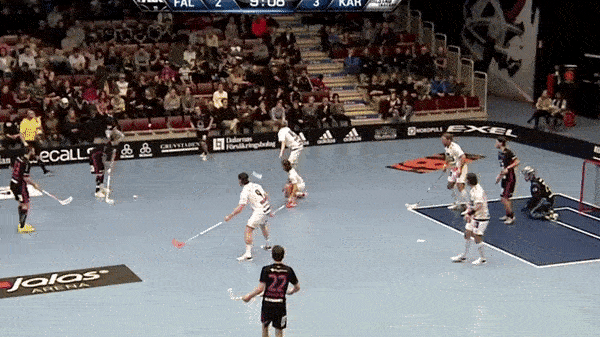
What’s going well with this free hit?
Think for a moment.
There are several reasons why this free ball is successful.
One of the reasons, of course, is that Galante is one of the best snipers of the game.
But the truth is, his shot only is a small part of what makes this a successful free hit. In fact, there are a couple of crucial “tricks” that he and his team perform. In this article, I gathered some of them and call them “rules”.
They are basic rules that all professional players follow – mostly unconsciously after years of practice.
The good news is that these rules are relatively simple to apply. Everyone can introduce them to their game and make their free hits more effective – without too much effort.
I’ll start the article with the 3 rules followed by a couple of some dos and don’ts. Then I’ll show you three successful examples from the SSL. At the end of this article, you will know exactly what went well with Galante’s successful free hit, and hopefully, you’ll be just as successful as Falun applying the rules into your own floorball game.
Time to start!
The referee whistles: free ball to your advantage!
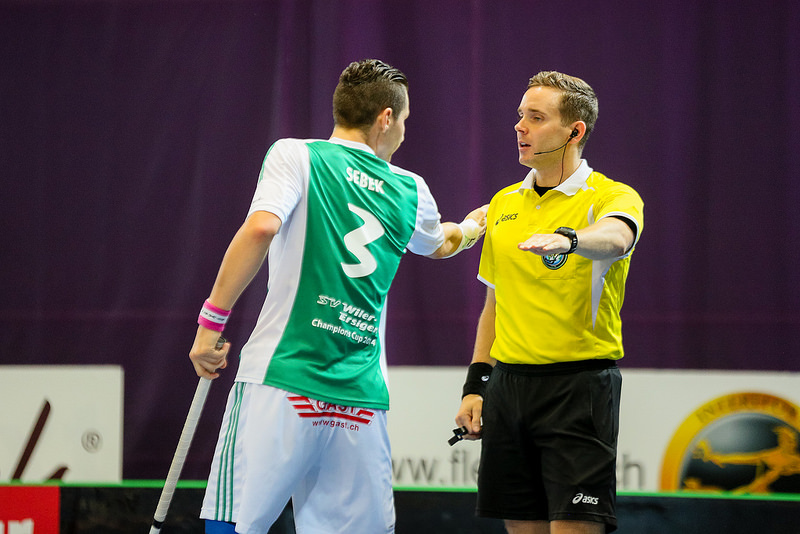
What happens now? This varies from team to team but chances are it goes something like this:
The teammate that likes to shoot most walks towards the ball and sees if he can find any excuse to shoot directly on goal. Seeing that this will most likely end up in a red ball-shaped bruise on the leg of the defender that is blocking the shot, he tries to find a teammate that is closest to him to pass him the ball so he can shoot around the defenders. The other teammates just watch the whole scene and are standing somewhere nearby, not really focused on the ball or on the goal. Because they are not a threat, the defenders have an easy time blocking the shot since they only have to focus on two players. Sometimes one of the two forwards is near the goal.
The shot goes into the wall 9 times out of 10, giving the opponent an opportunity for a counter.
Was it a successful free hit for us? No.
What is the goal of a free hit?
Is this a stupid question? I don’t think so. It is good to have an aim for your free ball, no matter how obvious, in order to be able to decide (as a team/line) how to reach this goal. Let me put the most obvious goal into words:
The goal of a free ball is to create at least one good shot, and – if the possible rebound is counted – in some cases even two.
In fact, this means that one of the first agreements we should make is that the free ball can hardly ever be shot directly at goal.
After all, there is almost always a player in the path of the shot, as a wall. If this player isn’t there (yet), don’t hesitate to shoot – but don’t do it if the opponent has put three people in the path of the shot!
This is our first rule.
Rule 1: never shoot directly if the path of the shot is blocked
Yes, I feel stupid for saying it but we have to start somewhere.
Let’s take a look at the situation below:

In the picture above, our team, the blue crosses, has the ball on the left side of the field. Does the situation look familiar to you? It’s about how Galante scored his goal.
The blue cross at the ball – Rasmus Enström in the GIF – takes the free ball. At this moment there are two players available to receive the ball: Thomas Holmgren, the blue cross on the middle line, and Alexander Galante Carlström, who walks in.
You can see that the three defensive pink circles are focused on the three blue players around the ball but thanks to Galante’s running action there is still room for the shot.
Read more about Rule 2 and Rule 3 in the next part of this article!
[ppp_non_patron_only]As much as we love floorball, we dedicate a lot of time and money to the FloorballToday project (more info here). That's why we ask you for a small monthly donation. By clicking the button below you can become one of our supporters and read the rest of the article. Thanks a lot! Already a patron? Then here is where you can login. [/ppp_non_patron_only][ppp_patron_only level="6" silent="no"][ppp_patron_only level=”6″ silent=”no”]
In addition, you can also see that there is a ‘lonely’ player on the right-hand side of the screen on what you may call the help side. He cannot receive the ball directly, but he can do so in two steps: if the ball is played back to our hindmost player, he can pass it to the right side of the field. If there is a lefty player here, a direct shot at goal can still follow.
Rule 2: the deepest player stands in front of the goalkeeper
If we have a free ball in the opponent’s half, make sure that one of your forwards is always near the goal and the goalkeeper – preferably even half a meter in front of the goalkeeper.
Why are you doing this?
There are a number of reasons, but the most important one is screening: taking about the goalie’s view on the ball by standing in front of him.
Think back to the Green goals in the Royal Road article: shots where the goalkeeper had less than half a second to see the ball coming, had a great chance to be upgraded to a goal.
So always make sure that the top forward is in front of the goalkeeper. He can distract the goalkeeper, but what’s a nice bonus is that he can also try to score any rebounds. Two birds with one stone! Or… three, because there’s another reason to stand here: you often distract at least one defender, and sometimes even two.
Rule 3: everyone participates
Just as you expect your whole line to help in the offense, and you also expect all your team-mates to help in defense, you also want a free ball to have everyone potentially involved. This means that every player does their bit. The roles of the shooter and the passer speak for themselves, but what do the other three do then?
We have already discussed the deepest forward: this one screens and is ready for the rebound. The remaining two make sure they are ready to shoot, even though they might not be the first option to play the ball to. However, if they show the opponent that they are ready, the opponent must keep a close eye on these persons too. This costs them extra effort, which increases the chances of a successful free ball!
Free extra advice: make sure you place your righty teammates on the left side of the ball, and your lefty teammates on the right side of the ball. Position them in such a way that everybody can take an instant shot if the ball happens to roll their way.
The do’s and don’ts
Now, what are the good points to practice, and above all, what not to do? We’ve summarized it below:
Dos
- Make sure you always have at least two people at the ball. If this is not the case, ensure that at least one player is moving towards the ball, e.g. to be able to tap the ball. One player with the ball is too easy to defend.
- Ensure that each teammate is ready and threatening towards the goal. If you stand with your back to goal, you cannot score, so the opposing team will have to focus less on you, which will give them more people to stop the rest of your team. The exception here is the screening forward.
- There is always someone in front of the goalkeeper to screen and grab rebounds.
- Discuss with your line and/or team about free hits, before or after training. Find a whiteboard, draw down the pitch and make sure each player knows what’s his role in the free hit system.
Don’ts
- Do not shoot directly at goal if there is a wall in between as there is a reasonable chance that you will lose the ball and get a counter.
- Can’t see a good opportunity to play the ball? Don’t shoot regardless. Go for a safe option, e.g. playing the ball back to keep it in possession, and do not opt for a difficult lob pass towards the second post (or anything like that).
A piece of advice in defending a free ball is: make sure you always have as many people in the wall as your opponent has near the ball.
Examples from the SSL
Example 1: Växjö
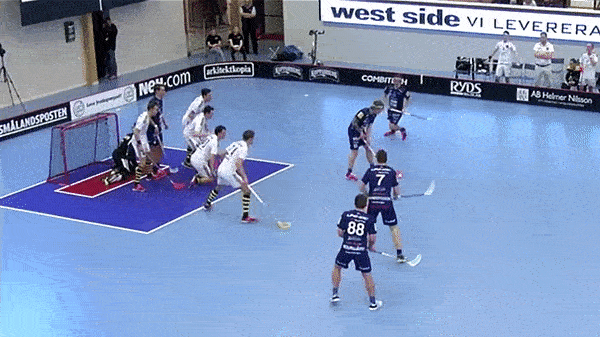
This is a beautiful free ball that is difficult to defend. Three people are actively involved and the player who touches the ball first even has his back to the goal, making it even harder for opponent AIK (now unfortunately no longer active at the highest level) to see where the ball is going.
The goalkeeper not only has almost his entire team in front of him, but also a fencing player. There is a wall in the path of the direct shot, but because Växjö decides to move the ball twice and the opponent runs out in the meantime, the space for the shot is created.
Three players are actively involved in the goal, one player a bit more passive (as a screener), but also #88 at the bottom of the screen is available for a one-timer; if something goes wrong during the execution of the free ball, he can also go for the shot from the left side of the field.
Example 2: Switzerland
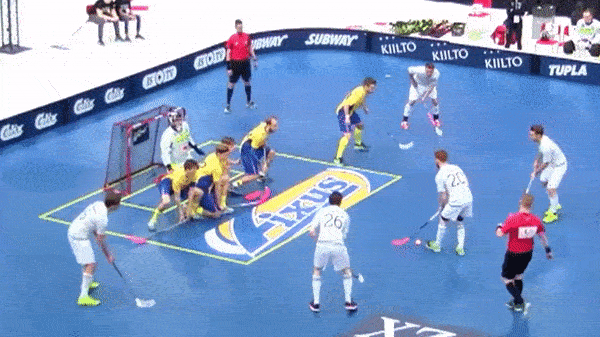
Switzerland and Sweden have frequently played against each other in recent years. During this match, Switzerland got a free ball on a fantastic spot. They are so close to the goal, that there was no room for the team to put down a player as a screener.
In this case, there’s no problem as instead, Switzerland decides to increase the threat to the goal. No less than three players are ready for the direct shot and on the right side, the fifth player is also (somewhat) ready.
What makes this free ball even more difficult for Sweden is that there are two possible shooters to the left of the shot and so it is not immediately clear to which of the two the ball will go. As the ball even moves back to the center of the field again, the whole Swedish organization is gone: the goalkeeper leaves the goal open and the neatly placed wall is broken up.
Example 3: Alexander Galante Carlström

We asked you at the beginning of this article what went well with this free ball, and we’re asking you again now. What points do you see coming back?
What I noticed about this free ball are the following points.
First of all, Enström has two good playing options. Next, Galante Carlström walks in and creates space for a direct shot, just along the wall.
Near the goalkeeper is the deepest player of Falun. He keeps two players of opponent Karlstad busy, namely the goalkeeper and the last defender. Finally, Emil Johansson (#22) is on the right side of the pitch. Suppose Galante had not seen the space to shoot, he could have played the ball (possibly indirectly) to Johansson as a back-up option.
More about free hits?
The free balls in this article are from a video by FG Floorball. If the article catches on, we will go deeper into free balls in a sequel article, but also how best to defend them. Possibly we can also use footage of less successful free balls, to see where things went wrong and how the team can do better next time.
We would like to hear from you if this was a nice and/or useful article, or why not. You can contact us via social media or Patreon!
[/ppp_patron_only]
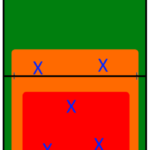



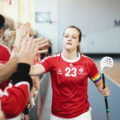


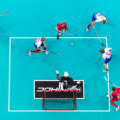


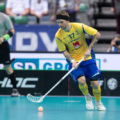
No Comments
Leave a comment Cancel